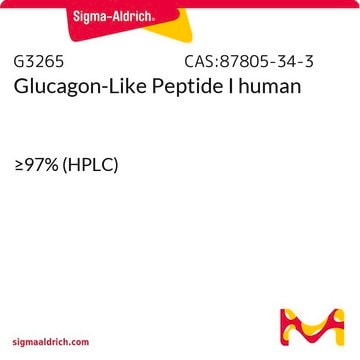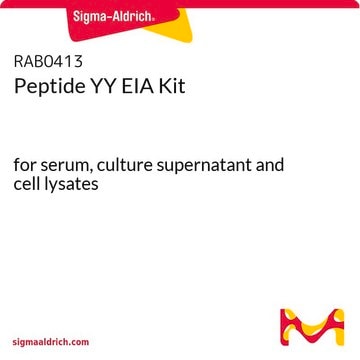EZGLP1T
Multi Species GLP-1 ELISA Kit
measures total GLP-1 levels in 20 µl - 50 µl serum, plasma or cell culture supernatent
Synonim(y):
Glucagon-like peptide-1
About This Item
Polecane produkty
product name
Multi Species GLP-1 Total ELISA, EZGLP1T-36K, This Multi Species GLP-1 Total ELISA, EZGLP1T-36K, is used to measure & quantify Glucagon Like Peptide-1 levels in Metabolism research.
Poziom jakości
reaktywność gatunkowa
human, mouse, rat
opakowanie
kit of 1 × 96 wells
Parametry
20—50 μL sample volume (4hr assay)
assay range
linearity: 90-132%
recovery range: 90-110%
sensitivity: 1.5 pM
(MinDC)
standard curve range: 4.1-1000 pM
inter-assay cv: <12%
intra-assay cv: <5%
metody
ELISA: suitable
moc wejściowa
sample type cell culture supernatant
sample type plasma (K2 EDTA)
sample type serum
numer dostępu NCBI
numer dostępu UniProt
Zastosowanie
research use
metoda wykrywania
colorimetric (450nm/590nm)
Warunki transportu
wet ice
temp. przechowywania
2-8°C
informacje o genach
human ... GCG(2641)
Powiązane kategorie
Opis ogólny
Specyficzność
GLP-1 is conserved in almost all mammals.
Zastosowanie
Metabolism
Oświadczenie o zrzeczeniu się odpowiedzialności
Hasło ostrzegawcze
Danger
Zwroty wskazujące rodzaj zagrożenia
Zwroty wskazujące środki ostrożności
Klasyfikacja zagrożeń
Acute Tox. 3 Dermal - Acute Tox. 4 Inhalation - Acute Tox. 4 Oral - Aquatic Chronic 2 - Met. Corr. 1 - Skin Sens. 1
Kod klasy składowania
6.1C - Combustible acute toxic Cat.3 / toxic compounds or compounds which causing chronic effects
Certyfikaty analizy (CoA)
Poszukaj Certyfikaty analizy (CoA), wpisując numer partii/serii produktów. Numery serii i partii można znaleźć na etykiecie produktu po słowach „seria” lub „partia”.
Masz już ten produkt?
Dokumenty związane z niedawno zakupionymi produktami zostały zamieszczone w Bibliotece dokumentów.
Klienci oglądali również te produkty
Nasz zespół naukowców ma doświadczenie we wszystkich obszarach badań, w tym w naukach przyrodniczych, materiałoznawstwie, syntezie chemicznej, chromatografii, analityce i wielu innych dziedzinach.
Skontaktuj się z zespołem ds. pomocy technicznej









